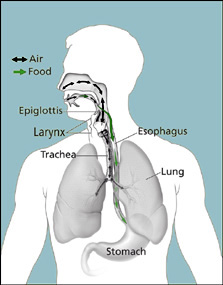Throat Cancer
Introduction:
This page has important information about cancer* of the larynx. Each year in the United States, more than 10,000 people learn they have this type of cancer.
This booklet discusses possible causes, symptoms, diagnosis, and treatment. It also has information to help patients cope with cancer of the larynx
The Larynx
The larynx is an organ at the front of your neck. It is also called the voice box. It is about 2 inches long and 2 inches wide. It is above the windpipe (trachea). Below and behind the larynx is the esophagus.
The larynx has two bands of muscle that form the vocal cords. The cartilage at the front of the larynx is sometimes called the Adam’s apple.
The larynx has three main parts:
- The top part of the larynx is the supraglottis.
- The glottis is in the middle. Your vocal cords are in the glottis.
- The subglottis is at the bottom. The subglottis connects to the windpipe.

This picture shows the main parts of the larynx.

This picture shows how the larynx looks from above. It is what the doctor can see with a mirror.
The larynx plays a role in breathing, swallowing, and talking. The larynx acts like a valve over the windpipe. The valve opens and closes to allow breathing, swallowing, and speaking:
- Breathing: When you breathe, the vocal cords relax and open. When you hold your breath, the vocal cords shut tightly.
- Swallowing: The larynx protects the windpipe. When you swallow, a flap called the epiglottis covers the opening of your larynx to keep food out of your lungs. The food passes through the esophagus on its way from your mouth to your stomach.
- Talking: The larynx produces the sound of your voice. When you talk, your vocal cords tighten and move closer together. Air from your lungs is forced between them and makes them vibrate. This makes the sound of your voice. Your tongue, lips, and teeth form this sound into words.

This picture shows the larynx and the normal pathways for air and food
What Is Cancer?
Cancer begins in cells, the building blocks that make up tissues. Tissues make up the organs of your body. Normally, cells grow and divide to form new cells as your body needs them. When cells grow old, they die, and new cells take their place.
Sometimes this orderly process goes wrong. New cells form when the body does not need them, and old cells do not die when they should. These extra cells can form a mass of tissue called a growth or tumor. Growths on the larynx also may be called nodules or polyps. Not all growths are cancer. Growths can be benign or malignant:
- Benign growths are not cancer:
- They are rarely life-threatening.
- Usually, benign tumors can be removed, and they seldom grow back.
- Cells from benign tumors do not spread to tissues around them or to other parts of the body.
- Malignant growths are cancer:
- They are generally more serious and may be life-threatening.
- Malignant tumors usually can be removed, but they can grow back.
- Cells from malignant tumors invade and damage nearby tissues and organs. Also, cancer cells can break away from a malignant tumor and enter the bloodstream or lymphatic system. That is how cancer cells spread from the original cancer (the primary tumor) to form new tumors in other organs. The spread of cancer is called metastasis. Different types of cancer tend to spread to different parts of the body.
Cancer of the larynx also may be called laryngeal cancer. It can develop in any part of the larynx. Most cancers of the larynx begin in the glottis. The inner walls of the larynx are lined with cells called squamous cells. Almost all laryngeal cancers begin in these cells. These cancers are called squamous cell carcinomas.
If cancer of the larynx spreads (metastasizes), the cancer cells often spread to nearby lymph nodes in the neck. The cancer cells can also spread to the back of the tongue, other parts of the throat and neck, the lungs, and other parts of the body. When this happens, the new tumor has the same kind of abnormal cells as the primary tumor in the larynx. For example, if cancer of the larynx spreads to the lungs, the cancer cells in the lungs are actually laryngeal cancer cells. The disease is called metastatic cancer of the larynx, not lung cancer. It is treated as cancer of the larynx, not lung cancer. Doctors sometimes call the new tumor “distant” disease
Cancer of the Larynx: Who’s at Risk?
No one knows the exact causes of cancer of the larynx. Doctors cannot explain why one person gets this disease and another does not. We do know that cancer is not contagious. You cannot “catch” cancer from another person.
People with certain risk factors are more likely to get cancer of the larynx. A risk factor is anything that increases your chance of developing this disease.
Studies have found the following risk factors:
- Age. Cancer of the larynx occurs most often in people over the age of 55.
- Gender. Men are four times more likely than women to get cancer of the larynx.
- Race. African Americans are more likely than whites to be diagnosed with cancer of the larynx.
- Smoking. Smokers are far more likely than nonsmokers to get cancer of the larynx. The risk is even higher for smokers who drink alcohol heavily.
People who stop smoking can greatly decrease their risk of cancer of the larynx, as well as cancer of the lung, mouth, pancreas, bladder, and esophagus. Also, quitting smoking reduces the chance that someone with cancer of the larynx will get a second cancer in the head and neck region. (Cancer of the larynx is part of a group of cancers called head and neck cancers.)
- Alcohol. People who drink alcohol are more likely to develop laryngeal cancer than people who don’t drink. The risk increases with the amount of alcohol that is consumed. The risk also increases if the person drinks alcohol and also smokes tobacco.
- A personal history of head and neck cancer. Almost one in four people who have had head and neck cancer will develop a second primary head and neck cancer.
- Occupation. Workers exposed to sulfuric acid mist or nickel has an increased risk of laryngeal cancer. Also, working with asbestos can increase the risk of this disease. Asbestos workers should follow work and safety rules to avoid inhaling asbestos fibers.
Other studies suggest that having certain viruses or a diet low in vitamin A may increase the chance of getting cancer of the larynx. Another risk factor is having gastroesophageal reflux disease (GERD), which causes stomach acid to flow up into the esophagus.
Most people who have these risk factors do not get cancer of the larynx. If you are concerned about your chance of getting cancer of the larynx, you should discuss this concern with your health care provider. Your health care provider may suggest ways to reduce your risk and can plan an appropriate schedule for checkups.
Symptoms
The symptoms of cancer of the larynx depend mainly on the size of the tumor and where it is in the larynx. Symptoms may include the following:
- Hoarseness or other voice changes
- A lump in the neck
- A sore throat or feeling that something is stuck in your throat
- A cough that does not go away
- Problems breathing
- Bad breath
- An earache
- Weight loss
These symptoms may be caused by cancer or by other, less serious problems. Only a doctor can tell for sure





































